
“You’re gonna need a bigger bookshelf!”
Hot on the heels of the release of EXOTIC ADVENTURES OF ROBERT SILVERBERG, our collection of early men’s adventure magazine stories by the great Robert Silverberg, we’ve released another new MAM story and art anthology.
It’s titled MANEATERS: KILLER SHARKS IN MEN’S ADVENTURE MAGAZINES.
As the title indicates, this one is a collection of classic shark-related pulp adventure stories and artwork from MAMs published in the 1950s, 1960s and 1970s.
MANEATERS comes in both trade paperback and an expanded hardcover edition that includes two additional stories.
It’s available on Amazon worldwide, Barnes & Noble, and the Book Depository site, which offers free shipping worldwide. I also sell it — and all of the books I co-edit — in the online Bookstore connected to this site. (If you buy direct from me, you get free shipping via media rate mail in the US, and I’ll sign books and add any inscriptions you want on request.)
In addition to being the first collection of MAM shark attack stories and artwork ever published there are several things that make it even more special, including contributions from some people with notable shark-related credentials.
There’s a Foreword by Steve Cheskin — the guy who created the concept for the Discovery Channel’s popular annual “SHARK WEEK” set of shows.
There’s an Afterword by Jack Perez (aka Ace Hannah) writer/director of the 2009 cult classic MEGA SHARK VS. GIANT OCTOPUS, a movie that has some of the same gonzo DNA found in MAM killer critter stories.
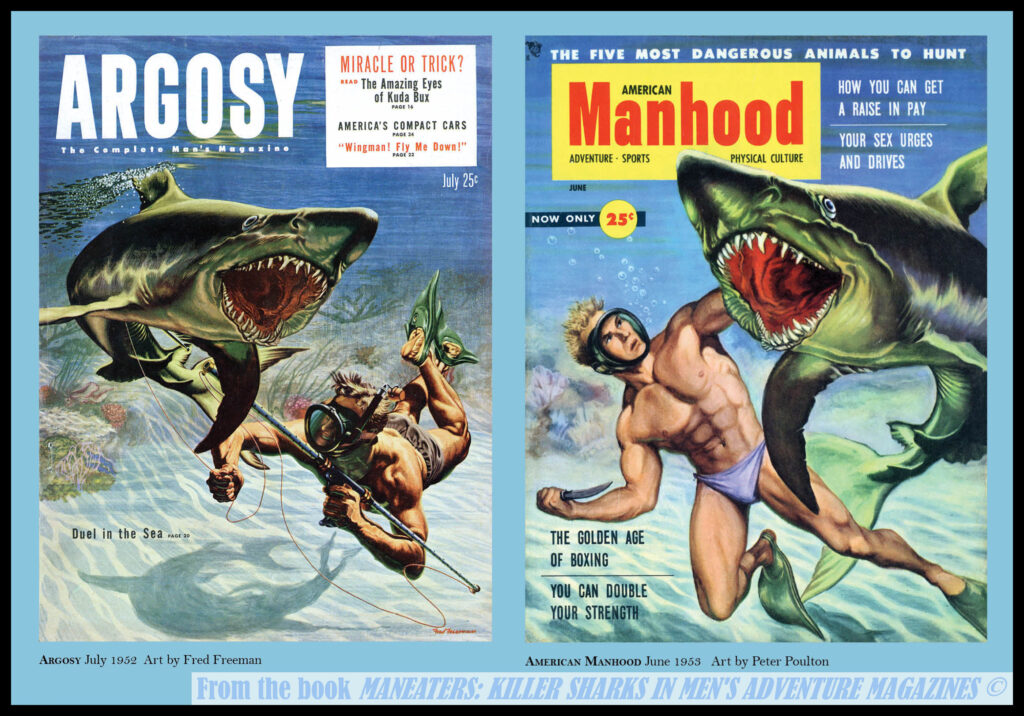
In addition, we invited 11 knowledgeable shark experts and scientists to write commentaries on which aspects of the stories in the book are myths about sharks and their behavior and which aspects are either somewhat true or, in a few cases, accurate.
One of the myths addressed in what we call these “Biting Back” commentaries is the common notion that sharks are mindless killers who target humans.
That myth was supercharged by the 1975 movie adaptation of Peter Benchley’s novel JAWS, which caused a surge of irrational fears and many indiscriminate killings of sharks. Benchley later regretted those side effects and became a vocal shark protection advocate.
Of course, it’s not a new myth. And, during the two decades before JAWS was released, men’s adventure magazines helped pave the way for JAWS-style stories and shark hysteria by regularly publishing scary shark attack yarns.
Indeed, given the popularity and ubiquity of MAMs in their time, I suspect the killer shark stories they featured were something Peter Benchley and JAWS director Steven Spielberg had been exposed to.
And, the artwork that goes with many shark MAM stories are forerunners of the iconic JAWS movie poster by Roger Kastel — an artist who also painted cover and interior artwork for MAMs.
The MAM painting we chose for the cover of MANEATERS is an awesome scene created by artist Phil Ronfor, showing a huge shark menacing a diver.
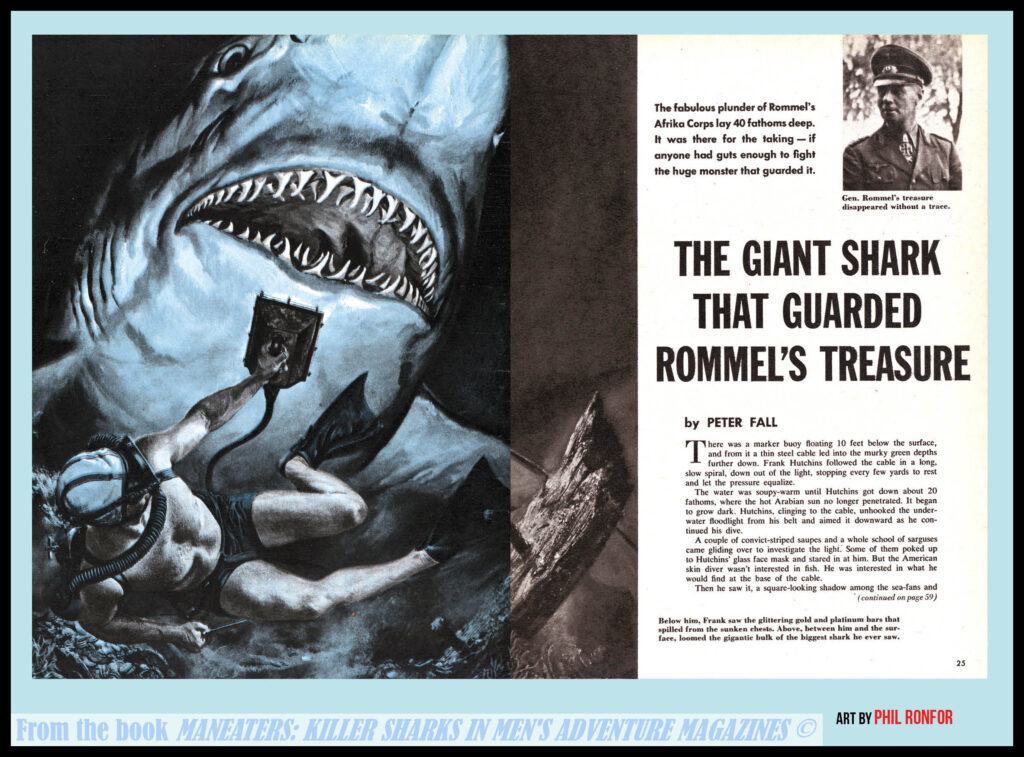
It comes from one of the stories included in the book: “The Giant Shark That Guarded Rommel’s Treasure,” originally published in the men’s adventure mag FURY, January 1961.
Wyatt and I fully understand that, in the real world, unprovoked shark attacks on humans are rare and those uncommon incidents generally involve only a few species.
We both strongly support shark conservation efforts and despise the senseless killing of sharks for “sport” and the despicable practice of shark “finning,” in which commercial fishermen cut the fins off sharks, throw their still living bodies back into the ocean to die, and sell the fins to makers of Chinese shark fin soup. (Man is indeed the most dangerous and cruelest creature on, in or out of the water.)
However, we still can and do appreciate the awesome, escapist thrill of good old, pulpy men’s adventure mag shark attack yarns and the great illustration art used for them. Even the shark experts who wrote mythbusting commentary for the book were awed by how cool the stories and art they commented on are.
For example, when marine conservation biologist David Shiffman received his copy, he posted a selfie of himself with the comment: “Just got my copy of Maneaters: Killer Sharks in Men’s Adventure Magazines, which features experts (including myself) telling the true science behind some past stories of sharks in pop culture. It’s a blast, check it out.”
Shiffman is an award-winning science educator and writer who maintains the popular WhySharksMatter Twitter feed. He provided commentary on the story “Shark-battling Dolphins Saved My Life,” originally published in MAN’S WORLD, February 1973.
It’s a cool story is made even cooler by artist Ken Barr’s illustration, which is used inside and featured in a colorized inset panel on the cover.

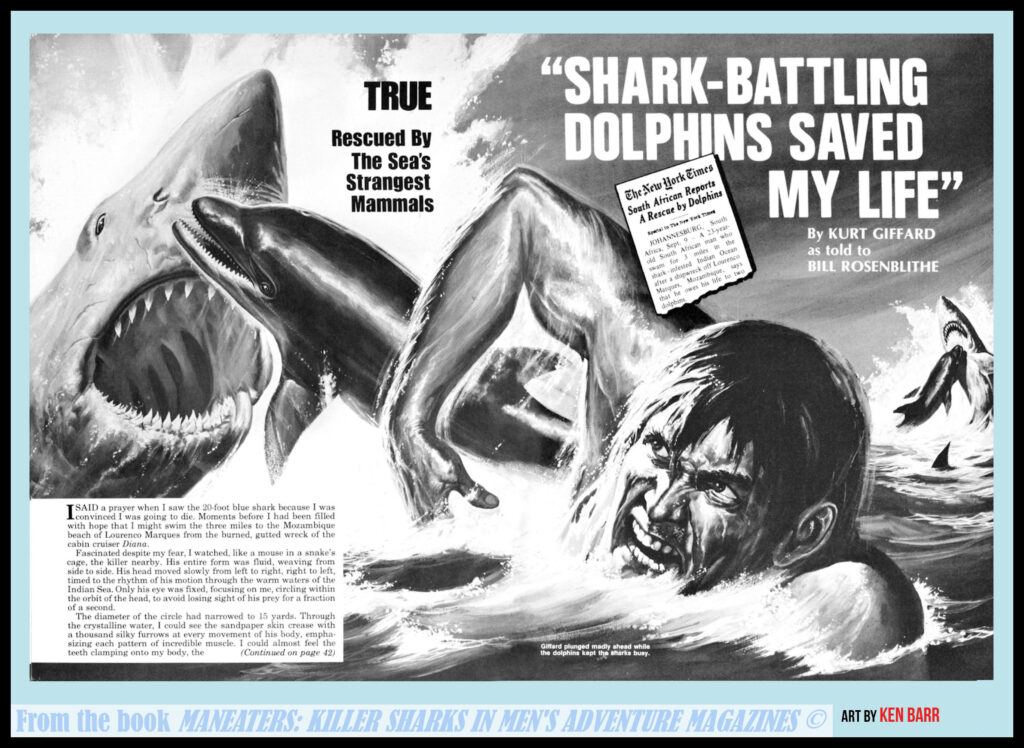
The story “I Fought the Suez Sea Beast,” from ADVENTURE, March 1957, features artwork by Mort Künstler.
Mort is one of the greatest of all illustration artists and later became famous for his historical paintings. We showcased 100 of his classic MAM cover and interior illustrations in our book MORT KUNSTLER: THE GODFATHER OF PULP FICTION ILLUSTRATORS.
In MANEATERS, we include a special interview with Mort, a gallery of his MAM artwork that features sharks, and some reference photos he used that have never before been published.
The “Biting Back” commentary on “I Fought the Suez Sea Beast” was provided by Bruce Avera Hunter.
He studied Oceanography at the University of Maryland and is a top nature photographer for National Geographic and other online and print publications.
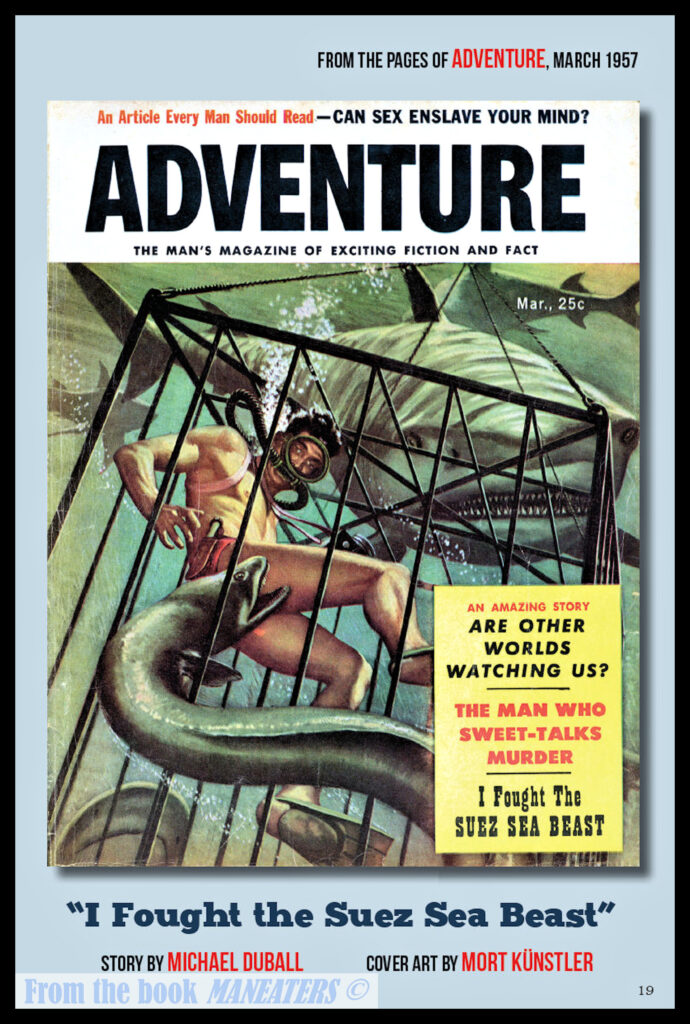
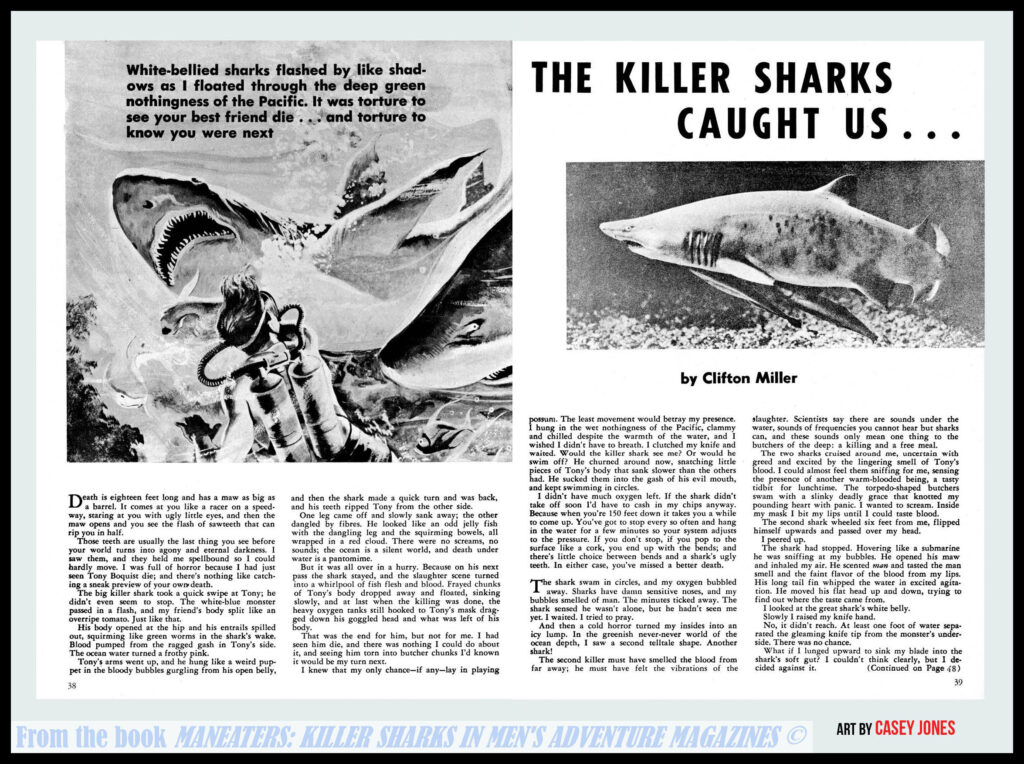
Bruce notes that tiger sharks, like the one shown in Mort’s illustration for that story, are one of the more dangerous species. However, he says, the “story’s presentation of the moray eel is rather hilariously unbelievable.”
Of course, as fans of Mort and the movie THE DEEP, we don’t mind; we like the crazy combo of a giant killer shark and a giant moray eel!
The story “The Killer Sharks Caught Us…” from PERIL, August 1957, is commented on by Jessica Myers, a marine scientist who is currently pursuing a Masters in Degree Coastal and Marine Systems Science at Texas A&M University.
Among many other interesting things, Jessica’s “Biting Back” commentary notes: “The narrator mentions slicing the shark open, and suggests it couldn’t swim because he thought he cut its swim bladder. But sharks don’t have swim bladders. Instead, they have a really large liver. Oil and water don’t mix; oil floats to the top. A sharks’ liver is very oily, and that’s what causes them to stay neutrally buoyant in the water.”
The story “Shark Bait,” illustrated by artist Syd Shores, tells a tale about six people who struggle to survive and onslaught of sharks when their DC-4 airplane crash lands in the Pacific. It was originally published in REAL MEN, September 1958.
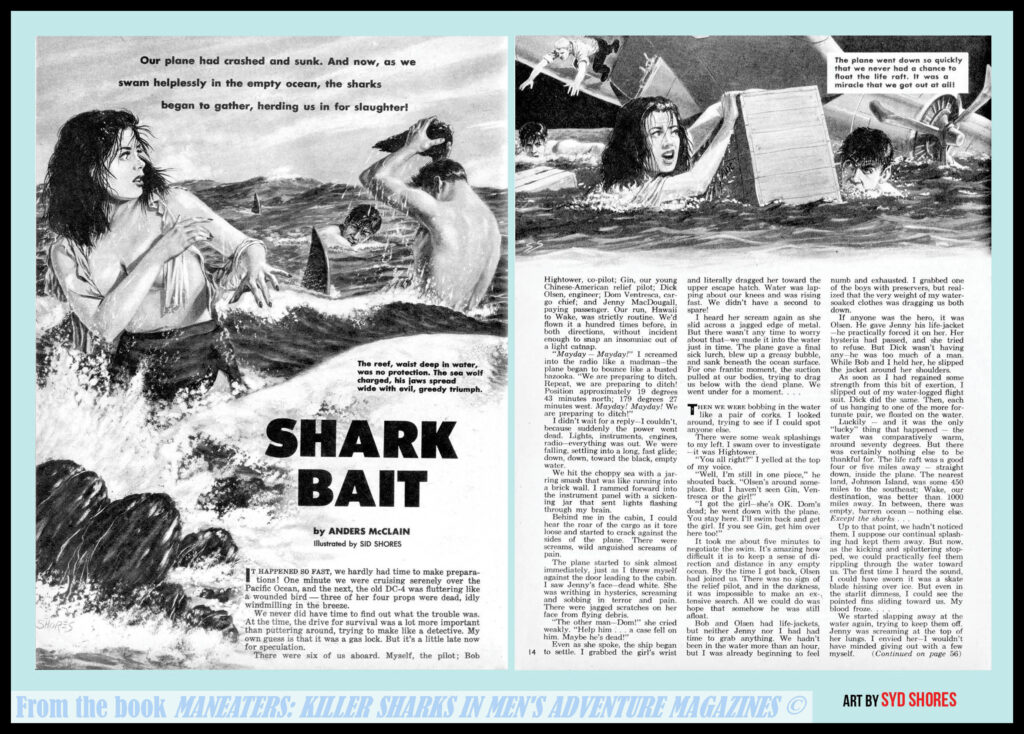
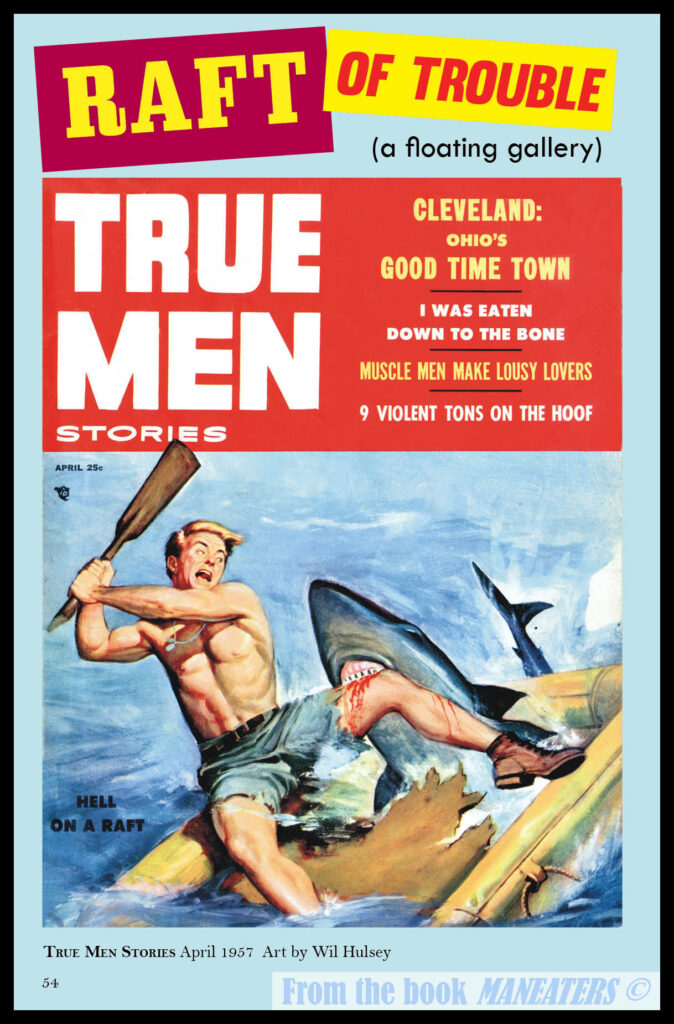
Commentary on “Shark Bait” is provided by Mark Royer, Ph.D. Mark has studied shark behavior at the Hawai’i Institute of Marine Biology Shark Lab and showcases his photographs of marine life on www.SharkMarkPhotography.com.
Mark says he believes the sharks portrayed in the story are oceanic whitetip sharks (Carcharhinus longimanus) and notes that the story “reads similar to the accounts of several US Navy sailors and pilots who experienced shark attacks after bailing out of sunken ships and downed aircraft in the open ocean during the WWII Pacific Campaign.”
He also notes that this once common species is now critically endangered due to decades of bycatch (incidental catching) by commercial fishing fleets and direct targeted-fishing for their fins for shark fin soup.
The story “The Sharks Got My Legs” comes from MAN’S ADVENTURE, October 1959. It features a jaw-droppingly great cover painting by Clarence Doore, one of the top pre-WWII pulp mag and post-WWII MAM artists. The interior art is uncredited.
The story involves another plane crash in the Pacific. In it, a pilot and his girlfriend have a raft, but get surrounded by an aggressive horde of sharks. It’s a bloody — and bloody good — faux “true” story.
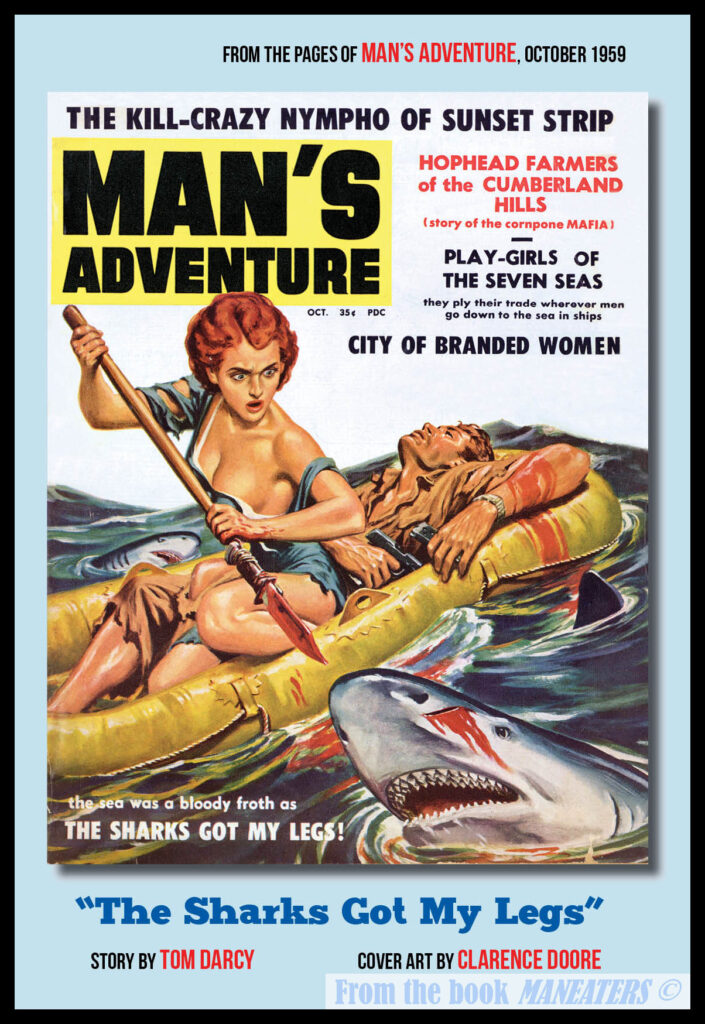
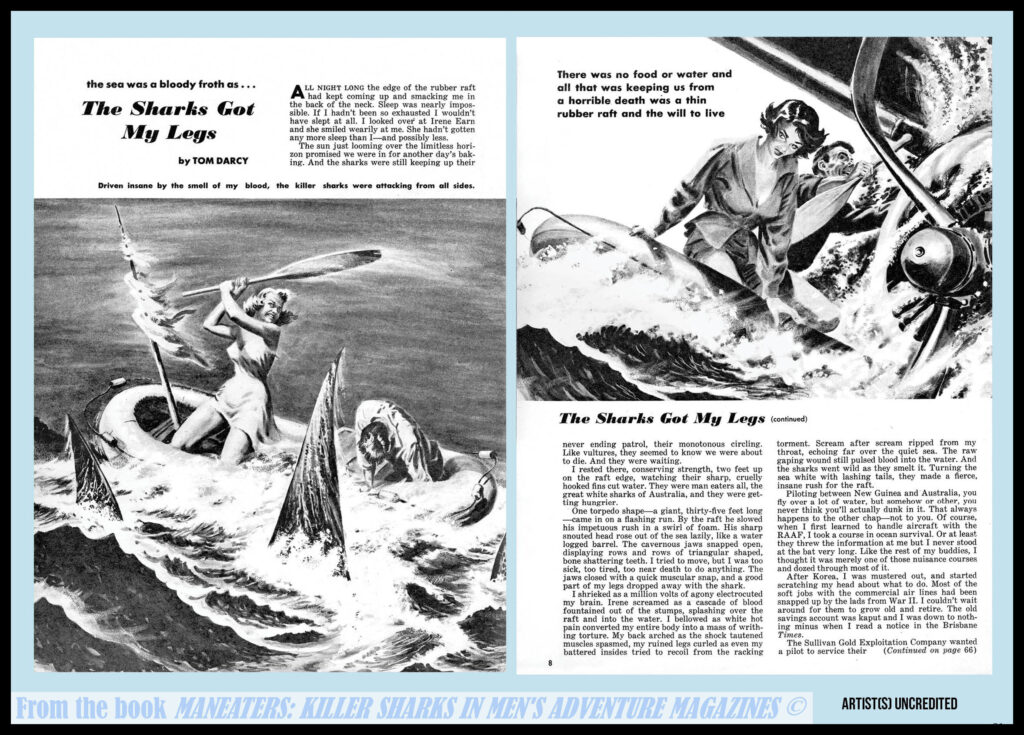
Our expert “Biting Back” commentary for it was written by Bryan Keller, who earned his Ph.D. studying shark ecology and currently pursues shark research and conservation efforts for the Save Our Seas Foundation.
Bryan provides some fascinating mythbusting facts. He also notes: “The end of the story really gets crazy.” We agree. Naturally, to us, it’s good old pulpy MAM craziness.
Tyler Bowling, Program Manager for the International Shark Attack File at the Florida Museum of Natural History and Manager of the Florida Program for Shark Research, kindly gave us commentary on two over-the-top stories in the book: “The Shark Who Hated Women” from PERIL, August 1960 and “The Headhunting Shark That Destroyed a Texas Family” from FOR MEN ONLY, January 1976.
Both of those stories have great artwork, as shown here. Tyler points out factual errors in them in his commentaries. One of the prevalent myths he busts is the “rogue shark” trope — “a single shark responsible for recurring attacks because it now craves human flesh.”
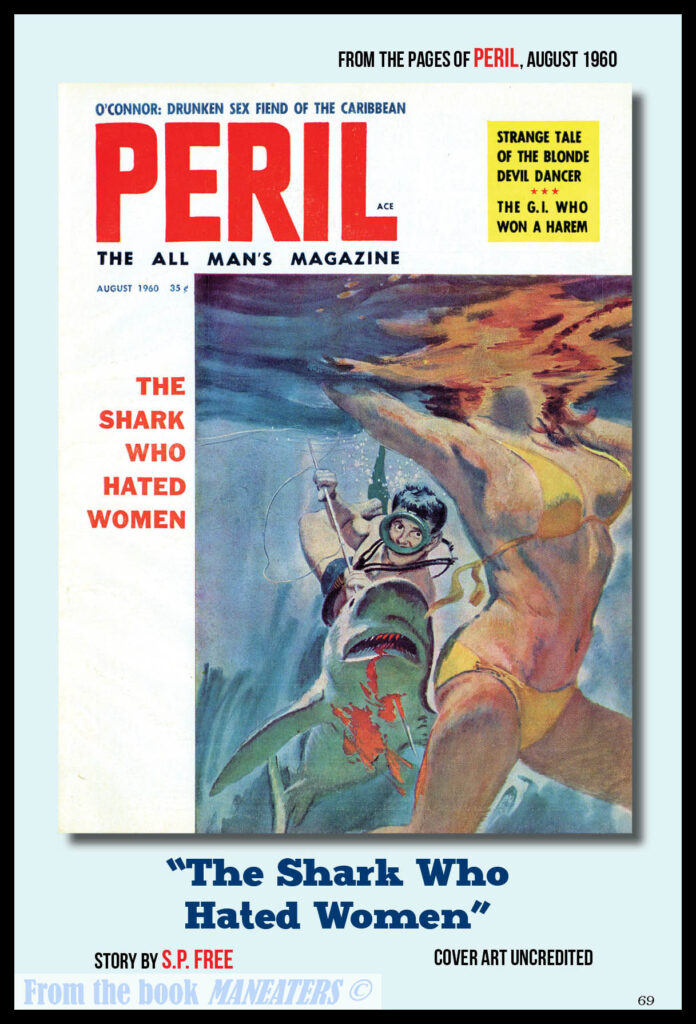
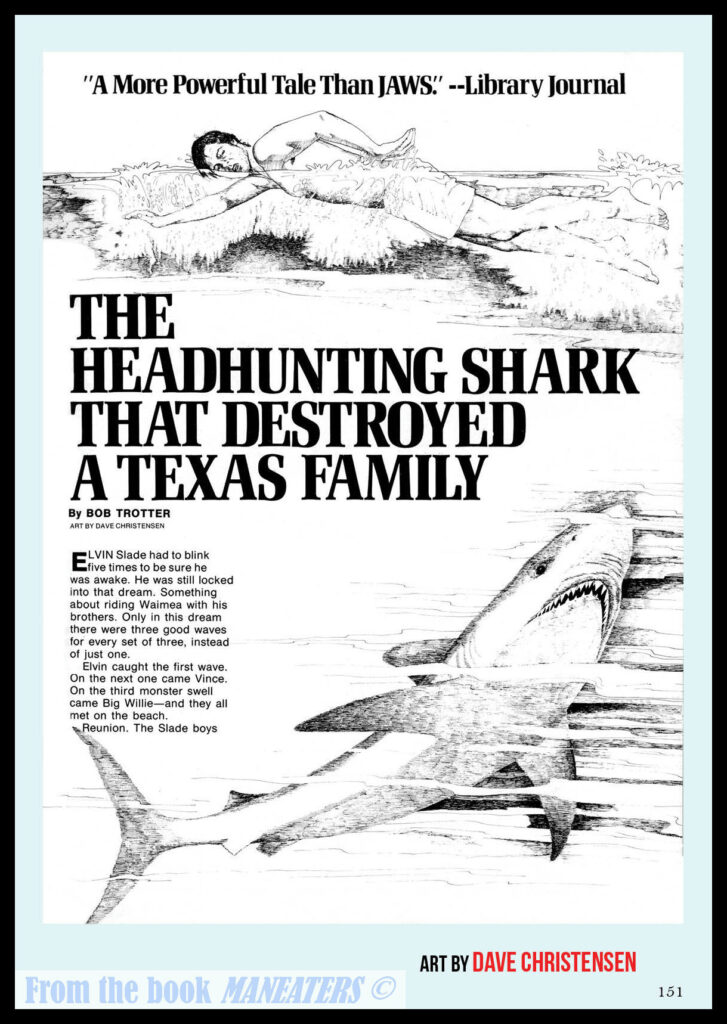
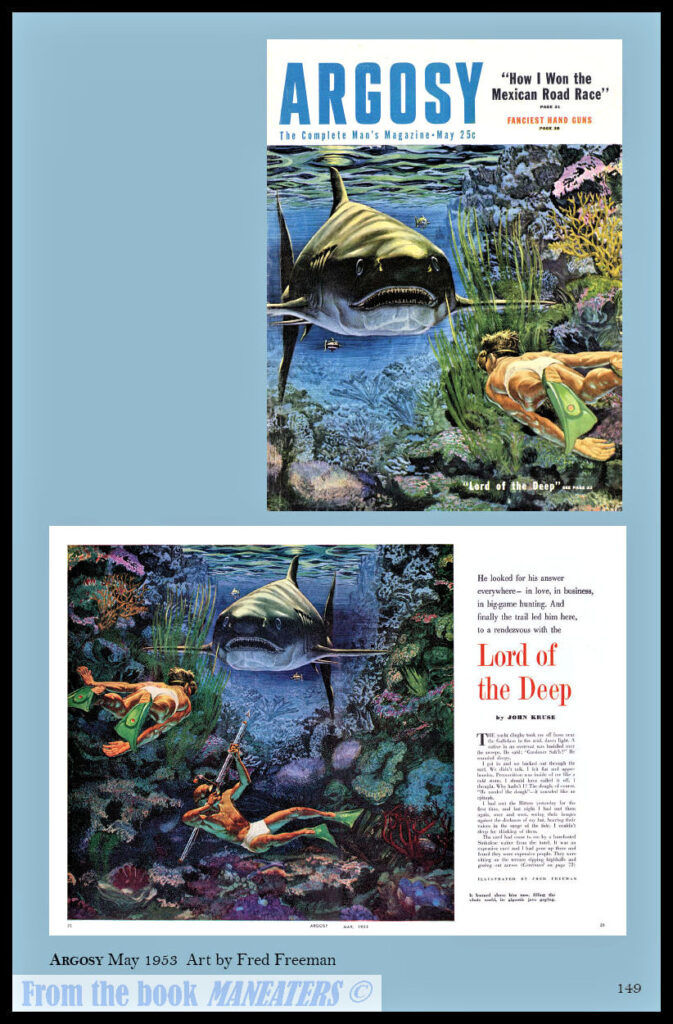
That trope is in both stories — and, of course, in JAWS, JAWS II, JAWS III and countless other movies, TV shows and books. Tyler explains that the International Shark Attack File “has never found any data to support this fear-mongering hypothesis.” But that doesn’t take away from how damn cool these two stories in MANEATERS are.
Another story in the book, from SPORTSMAN, November 1964, has the shocking title “My God, the Sharks Got the Women!” Yep, that gives a hunt at what’s in store for readers.
Marine fisheries biologist Sarah Fae Torre provided the “Biting Back” commentary for us on that one. In it, she reminds us of a key shark fact: “Humans have very little nutritional value to sharks in comparison to seals, tuna, and other large fish they may hunt. It is likely that if a shark ‘attacks’ a person, the fish will release them nearly instantly, realizing that this is not their intended meal.”
Of course, facts never got in the way of the ripping yarns in MAMs, especially when sharks are doing the ripping.
One of my favorite stories in the book is “E Mao Ariki,” originally published in ARGOSY, July 1968. It was written by Robert Edmond Alter. If you’ve never read anything by Alter, this is a good place to start. It’s one of two shark stories by Alter in MAMs that I know of. The other is “The Monster of Madrepore” in ARGOSY, July 1960, featuring artwork by Jack Hearne
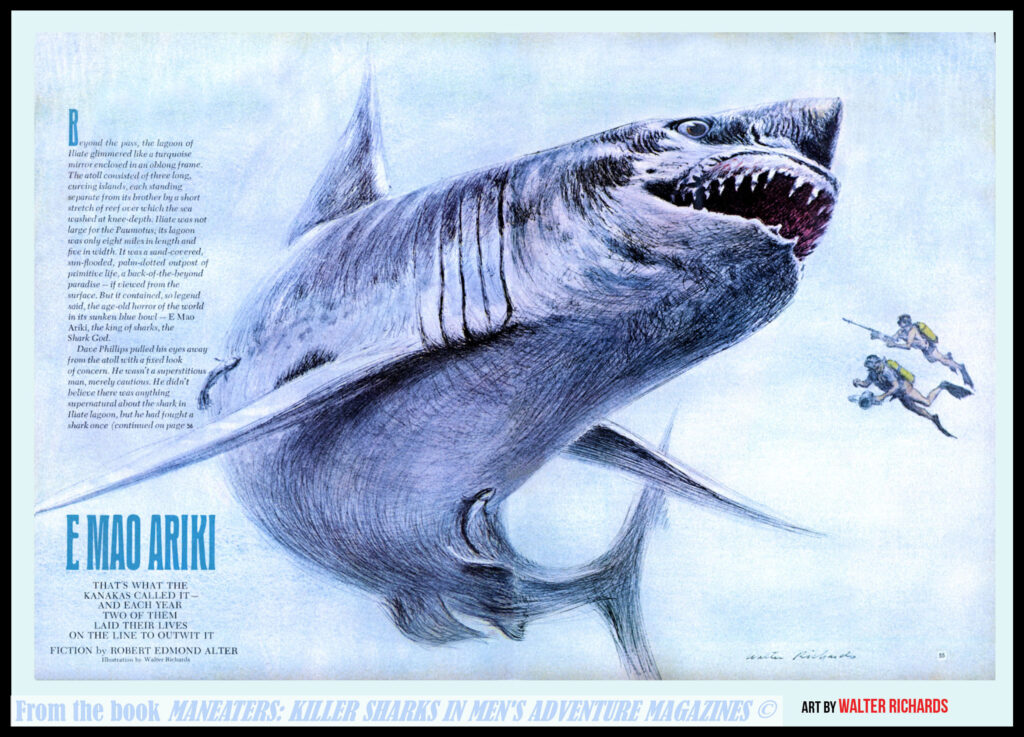
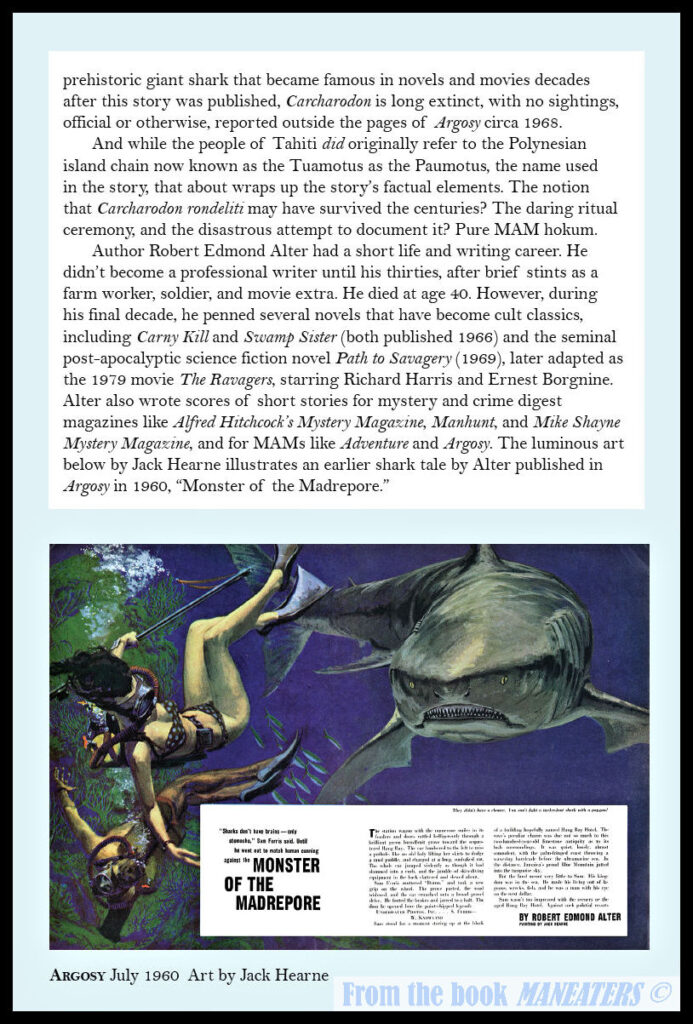
Long before the movie MEGALODON, this story by Alter tells a bloody tale about a similar monstrous shark species that’s supposed to be extinct, Carcharodon rondeliti — awesomely portrayed in the illustration by artist Walter Richards.
Alter died way too young, at age 40, in 1966. However, he penned several novels that have become cult classics, including CARNY KILL (1966) and the seminal post-apocalyptic science fiction novel A PATH TO SAVAGERY (1969), later adapted as the 1979 movie THE RAVAGERS, starring Richard Harris, Ernest Borgnine, Ann Turkel and Art Carney. He also wrote short stories for mystery and crime digest magazines like ALFRED HITCHCOCK’S MYSTERY MAGAZINE, MANHUNT, and the MIKE SHAYNE MYSTERY MAGAZINE, as well as for top tier MAMs like ADVENTURE and ARGOSY.
That fiction yarn is followed by a story that’s portrayed as a true news article: “US Shark Epidemic Coming This Summer!” It was first published in ACTION FOR MEN, July 1970. The subhead blares: “From Long Island Sound to California beaches, sharks, the most vicious of creatures, are now on a wild rampage for human flesh!”
Did that happen? Nah. But it’s a good example of the kind of stories that presaged JAWS.
The commentary by marine ecologist Chuck Bangley, Ph.D., notes, among other things: “While this correctly rings as ridiculous hyperbole, it’s not too far off from what can be heard in the more sensationalist Shark Week installments of the last few years.”

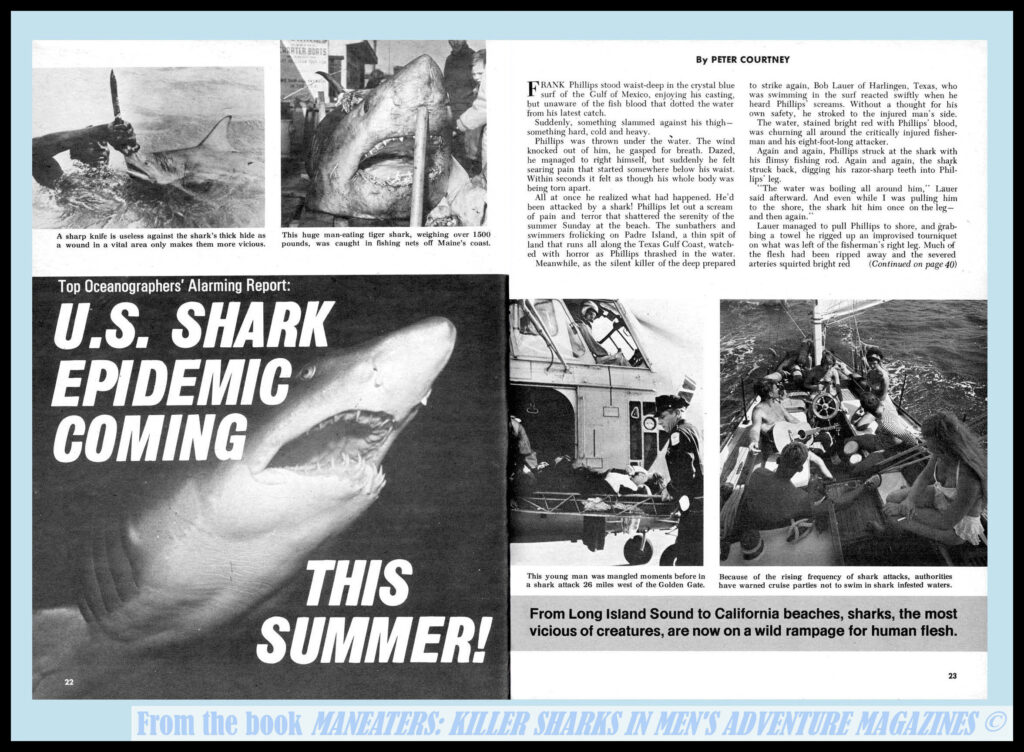
Another purportedly true story in MANEATERS is “A Man-Eating Shark Pack Against Scuba Divers,” from ACTION FOR MEN, January 1975. Yannis Papastamatiou, a Ph.D. scientist who studies marine predator ecology, provided commentary for it. Among the facts he points out is this: “While humans have been consumed by sharks, this is a very rare occurrence, even amongst species that may take large prey (e.g. white sharks).”
Now, personally, I love sharks. I’ve dived and snorkeled with various species a number of times in the waters around the Florida Keys, where I live, and in the Caribbean. Not long ago, in the Bahamas, I took my grandkids on a snorkel trip where we were surrounded by a “shark pack” — dozens of good size Blacktip Reef Sharks who were hand fed fish bits by our divemaster to attract them. It was a great experience. However, despite knowing that what Yannis said about Great Whites, I can’t say I wouldn’t be scared as hell if I were surrounded by a pack of them.

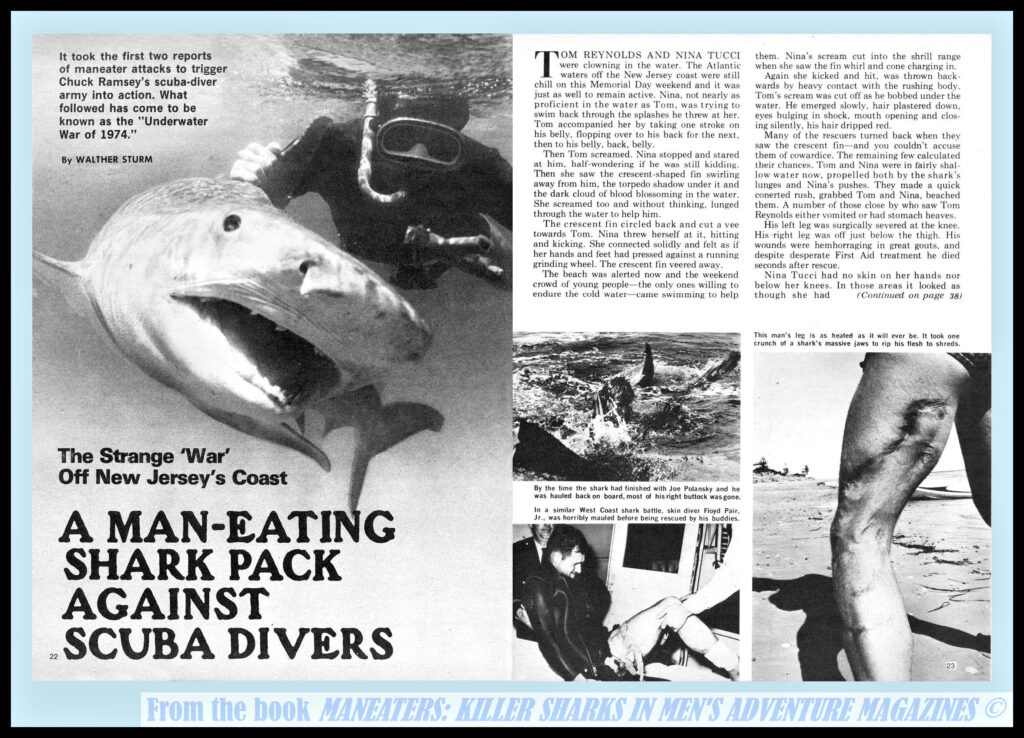
If you buy the hardcover edition of MANEATERS, one of the bonus stories you get in it is “My God—We’re Being Attacked by Tiger Sharks!” from TRUE ACTION, October 1972. The “Biting Back” commentary on that one was written by Gavin Naylor, Director of The Florida Program of Shark Research, Curator and Professor at Florida Museum of Natural History at the University of Florida.
The second bonus story in the hardcover edition — “The Madman Who Ruled a Killer-Shark Pack,” from MAN’S WORLD, January 1976 — has commentary by Caroline Collatos, a marine biologist who has recently been studying Sandbar sharks around Nantucket, Massachusetts.
MANEATERS includes some other stories that don’t have “Biting Back” commentaries and a number of classic MAM covers and illustrations that are separate from stories. But this blog post should give you a pretty good idea of what it’s like. You can also see an extensive preview on ISSUU.com that includes one complete story and its commentary.
All in all, we think this new book in our Men’s Adventure Library series is one of the best. And, simply put, there is no other book like it.
The men’s adventure magazine genre is extinct. The populations of many shark species are now in danger of extinction due to unfounded fears, misguided attempts at eradication, overfishing and climate change.
We hope this book sheds some light on both MAMs and sharks and, ultimately, helps both to live on.
CLICK THIS LINK TO SEE AN EXTENSIVE FLIP-PAGE PREVIEW OF MANEATERS ON ISSUU.COM


